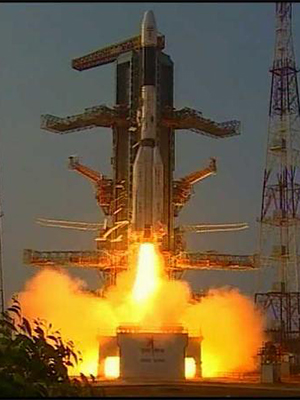
ISRO's GSLV-D6 launch a grand success
It brings the Indian space agency closer to its dream of becoming a commercial launcher of heavy satellites
India moved a step closer to establishing its credentials as a reliable low-cost launcher of heavier communication satellites with the successful launch of GSLV-D6 whose upper stage was powered by indigenously developed cryogenic engine. This success, the second, using the locally developed cryogenic engine, not only proved to the world that the first success in January 2014 was not a 'flash in the pan' but also sent a clear message to its competitors (NASA and European Space Agency) that the Indian Space Research Organisation (ISRO) is fast mastering the complex cryogenic technology.
The 49 metres-tall GSLV-D6 carrying a 2.12 tonne GSAT-6 communication satellite as its payload lifted off into a cloudy sky from the Sathish Dhawan Space Centre at Sriharikota at 4.52 pm on Thursday. It proved to be a textbook launch with the 416 tonne GSLV achieving all its milestones in its 17.04 minute flight and placing GSAT-6 in the intended orbit.
Commenting on the success, ISRO chairman Kiran Kumar said the design and other intricacies of the launch vehicle have been proved now and the space agency will have to repeat the success again and again to establish the reliability of GSLV. "The challenge now is capacity building. Build more launch vehicles and reduce the time between launches," he added. ISRO is targeting at least two GSLV launches every year going forward. The market for launching satellites weighing 2 tonnes is good, Kumar said, adding that ISRO's aim is to improve the payload carrying capacity to four tonnes using GSLV Mark III which is under development. "We are a good candidate for the commercial launch of communication satellites'" he said.
GSAT-6 is the 25th geostationary communication satellite built by ISRO and will be for predominantly 'government use'. The satellite's solar panels have been deployed and it is generating power. The next three days will see critical operations that will unfurl its 6 metre diameter antenna (largest ISRO has developed so far) and put the satellite in its final orbit.
This is the ninth launch of GSLV and the third using indigenously developed cryogenic engine (the first flight with a locally developed engine failed in April 2010).
ISRO's dream of developing the critical cryogenic technology -- which will allow it to put heavier satellites in geosynchronous orbits (an orbit where the satellite moves in tandem with India as earth rotates and thus it is available for use throughout the day) did not come easy. The programme which started way back in the 1990s, after Russia refused to give more than seven cryogenic engines under pressure from the US as it was seen as a dual use (for civil and military) technology, was plagued by delays. Though ISRO gained the capability to launch GSLV (Geosynchronous Satellite Launch Vehicle) by using the Russian engines (it launched the first GSLV with Russian cryogenic engine way back in April 2001), the development of its own engine was critical for the future of the GSLV programme. Lot of innovation, use of alternative alloys and involvement of the private sector helped ISRO overcome all the challenges.
The Indian space agency has already established its name as a reliable launcher of smaller satellites using PSLV (Polar Satellite Launch Vehicle) which recently registered its 29th consecutive successful launch. Next month it will be putting four nano satellites from the US in orbit. "More and more people are coming to us to use our launch vehicles for launching smaller satellites," Kumar said. He will be hoping that the same happens soon for heavier communication satellites as well.















